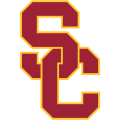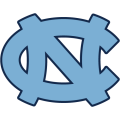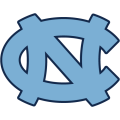Caleb Williams or Drake Maye? Here's how talent evaluators frame the 2024 NFL Draft's big question
Tucked into a booth in the Indianapolis Capital Grille nearly nine months ago, an AFC personnel man predicted a future dilemma in the NFL Draft. Sawing through a steak during a break in meetings at the league’s annual scouting combine, he paused between bites and mused about the forthcoming 2023 quarterback class.
He compared the physical size and football résumés of Alabama’s Bryce Young and Ohio State’s C.J. Stroud. He assessed which roster might be best equipped to cultivate the ceiling of Florida’s Anthony Richardson, versus which franchise had the right coaching staff to connect with the personality of Kentucky’s Will Levis. And when he was finally done with his meal, he made sure to deliver one last overarching assessment before getting up from the table.
“Next year is the one to be picking a quarterback at the top,” he said. “If Caleb Williams and Drake Maye were in this draft, they would’ve gotten picked before all of these guys.”
Asked which player he preferred between the USC and North Carolina quarterbacks, he wasted no time delivering an answer that was an outlier at the time.
“Maye,” he said. “I’m in the minority, but I’m a Maye guy. The kid’s a stud. He probably saved that entire coaching staff from getting fired this season.”
At the time — in early March of 2023 — he almost certainly was in a very small fraternity of NFL front offices and coaching staffs that would have leaned toward Maye as being the best quarterback between two players who were already earning the “generational” scouting cliché. But there was plenty of substance to push back against his assessment: Williams was coming off a Heisman-winning campaign and back-to-back seasons at Oklahoma and then USC that saw him showcase skills and playmaking ability that was rare on the planet, let alone just inside the confines of college football. So much so, he likely would have been a first-round pick if he’d been able to enter the draft after starting for the Sooners as a true freshman in 2021. If anything, the biggest complaint about Williams nine months ago was that teams were being forced to wait until 2024 for his draft eligibility to kick in.
That reality might have been best illustrated in late November of 2022, when Sean Payton, one of the league’s cornerstone quarterback whisperers, went on Colin Cowherd’s “The Herd” and speculated that Williams could be the superstar draft pick that finally pushes the league into a lottery system. At the time, Payton was taking a year off coaching and working as a Fox Sports analyst, delivering double-barreled football opinions about virtually anything and everything. His rationale on this particular day? That Williams was so special, teams could end up tanking on a shameless and undeniable level during the 2023 season just for the opportunity to draft him No. 1 overall. And with the NFL now embracing ancillary revenue streams tied to gambling, that tanking could ultimately fracture the league’s draft process.
“This player, I think, is the type of player that we would look back on in five years and say, ‘He’s why the lottery exists now,’” Payton said.
As much as that was a statement about some of the NFL’s intersecting and conflicting values, it was a declaration about what league evaluators thought of Williams. After all, this was the same Sean Payton who oversaw the most prolific portion of Drew Brees’ Hall of Fame career and who had success with some scrap heap quarterbacks, too. That makes it meaningful when he points at Williams and says this guy is special enough that teams are willing to break their seasons and the draft to get him.
In the 12 months since Payton made those remarks, very little of that aura around Caleb Williams has changed. He’s still seen by personnel officials and coaches as presenting a filthy-level talent. He still has parts of his game compared very favorably to Kansas City Chiefs quarterback Patrick Mahomes, who became the league’s gold standard measure for greatness following Tom Brady's retirement. And he’s still viewed through the prism of whether a team is tanking hard enough to have a shot at him. If you don’t believe that then comb through the social media agonizing of New England Patriots fans on Thursday night, when a 21-18 win over the Pittsburgh Steelers was largely absorbed as a massive defeat in draft positioning.
Despite all of that, the steady drumbeat for Williams — who won't play in this month's Holiday Bowl, USC head coach Lincoln Riley announced this week — as the draft’s unquestioned No. 1 pick is now fighting a contending cowbell in Drake Maye. With it, that once-small group that the AFC evaluator found himself in back in March is finding some creeping expansion heading into the next five months of draft assessments. While the shift might not be tectonic right now, it’s enough that of the 11 NFL talent evaluators who spoke to Yahoo Sports — each from a different team — four said they would prefer Maye over Williams. And of the seven who preferred Williams, six agreed that his standing as the first overall pick will depend on a confluence of factors that include coaching staff, scheme and preference in quarterback prototype.
All of which is to say one thing about the No. 1 pick: Caleb Williams versus Drake Maye still feels like an unsettled tug-of-war. And it will likely dominate the league’s draft marquee all the way into late April.
“We’re not even to the combine, so nothing about any evaluation should be assumed to be in the bag — about any player,” one NFC scout said. “I think generally, Caleb would be going into this part of the process, assuming he’s going to come out, he would be going into the combine at the top of a lot of quarterback boards, if not most. I definitely wouldn’t think it’s a 50-50 deal between him and Drake Maye across the league, or even as close as Bryce [Young] and C.J. [Stroud] last year. But I also don’t think it’s 90-10, either.”
“Putting percentages on them is just guessing,” the scout continued. “But I can say that they’re different enough as players that some staffs will definitely prefer one over the other.”
So what are those preferences going to come down to? The answers were wide-ranging and nuanced, but three themes consistently emerged. In no particular order …
Caleb Williams vs. Drake Maye: style of play
Get used to the phrase “on time and in structure” when comparisons are made between Williams and Maye. In essence, can they operate their scheme with rhythm and functionality, allowing the offense to run the way it was designed? Are they consistently doing what they’re supposed to be doing in terms of reads, depth of drop-backs, timing, etc.? And when they aren’t, can they create successfully when they go off script?
Between the two, Maye gets the better reviews when it comes to running plays in structure, while Williams gets the highest marks for being able to extend and improvise big plays. The flip side? Maye gets dinged in some assessments when it comes to mechanics and accuracy when he’s improvising, while Williams gets criticized for extending plays far beyond what could work on the NFL level.
“Maye can get relaxed with the details when he’s trying to create something, or sometimes even when he’s just on the move,” an AFC scout said. “Some of the inaccuracy comes down to cleaning that up. Guys that are really off-the-charts athletes can fall into bad habits because they’re so much better than everyone. That changes a lot when you play [in the NFL] and everyone is a great athlete.”
And Williams?
“[Caleb] does way too much at times where he won’t cut his losses and you’re thinking, ‘get rid of the f***ing ball,’” an NFC talent evaluator said. “There are times where he’s running around and takes sacks and the protection gets blamed, but it’s hard to blame the line on some of these plays where he’s just extending, extending, extending. To me, that’s some coaching, too. The coaches have to dial that in. But their defense was so bad, I don’t know how you tell the quarterback to stop trying to make every throw a big chunk play. They needed a lot of those plays to win games.”
One AFC North talent evaluator boiled it down simply: If a staff is looking for a good athlete who can run when the scheme dictates it, but who is going to operate the offense in line with a traditional pocket-passer mentality — like a Justin Herbert — Maye is going to fit the mold. But if they’re looking for a shorter Mahomes who is going to require some coaching and patience to rein in his temptation to freelance and hunt big plays, then Williams is their guy.
“Maye has a lot there that is easy to fit in with what is traditionally wanted with [quarterbacks] in our league,” he said. “But Caleb has some rare playmaking traits that you can really only compare to a few guys — the Mahomeses and [Josh] Allens, and Lamar Jacksons. It’s really just about what fits for you.”
Size
Sound familiar? We’re back to this again after last season's Bryce Young versus C.J. Stroud debate. Albeit not quite as dramatic this time around, but potentially a factor, nonetheless. As of now, Maye is listed at 6-foot-4 and 230 pounds. Williams comes in at 6-1 and 215.
How close will both be? It’s less relevant for Maye, who is going to be in a percentile close to what the NFL prefers in QB size. Williams will be a little more intriguing. If only because the recent groundswell of 6-1 and shorter starting quarterbacks have had some concerning injuries or struggles anchored by Young, Kyler Murray and Baker Mayfield.
But one evaluator in the Williams camp said the comparison to those players should include more data relevant to success, noting Williams is a better athlete with a much better arm than Mayfield; a better and taller athlete with a better arm than Young; and much taller than Murray.
“What about Jalen Hurts and Brock Purdy? Both around 6-1,” he said. “Maye is bigger, but Caleb Williams isn’t small at all. He plays big and he’s tough. He’ll also get stronger at the next level.”
Leadership/Intagibles
This will definitely be an interesting deep-dive area, although there are already strong split opinions on how to measure it. We can start with Williams’ three-year tradition of painting his fingernails for games, which occasionally directed some profane messages about opponents. The nails definitely stirred opinions. Two comments most accurately summed up feelings of talent evaluators.
One AFC scout put it: “It’s weird. It just is.”
And one NFC scout: “It’s stupid. It doesn’t matter. You’re not going to pass on him because of some painted fingernails.”
“F— Utah”
Caleb Williams is at it again with the nail art 👀 pic.twitter.com/Z94GJga5aI— Yahoo Sports (@YahooSports) December 2, 2022
It’s worth remembering in this instance that some teams once thought of Cleveland Browns defensive end Myles Garrett as being eccentric in their draft evaluations. The reality is in some respects, the league wants cookie-cutter personalities. And while neither is exactly cookie cutter, it’s fair to say Williams has drawn more scrutiny — from the fingernails, to going up in the stands after a game and crying with his mother, to not speaking with media after losing to UCLA, to his comment that everybody wants to be in his shoes.
All of that goes through different filters for evaluators. Some see what they think is underlying arrogance. Others think it’s nitpicking a guy who has been under an intense spotlight for years.
“He was one of the biggest recruits in the country,” an AFC personnel man said. “Then he was a big deal at the QB Collective workouts with Mike Shanahan and his whole [NFL] coaching tree. … Biggest thing at Oklahoma. Biggest thing at USC. Biggest expectations for the draft. All of that in three or four years of his life where he’s constantly under pressure and people are making an issue out of his fingernails or crying with his mom. If that’s the character flags, he’s going to be fine.”
Fair or not, questions about Maye’s leadership and intangibles typically circle his life in a family of high-level athletes. Two of his older brothers, Luke and Beau, played for the North Carolina basketball team — Beau is still currently on the team, while Luke is now playing professionally overseas. His third older brother, Cole, had a stint as a baseball pitcher for an NCAA title-winner at Florida. His father, Mark, was a starting quarterback for the Tar Heels in the 1980s and his mother, Aimee, was a star high school basketball player in Charlotte.
“The leadership and intangibles for both guys, it’s going to be what the [college] coaches are saying in the building, what the teammates are saying, and then the meetings with your own coaches and leaders,” a high-level AFC evaluator said. “Sometimes you think a player is going to be a breeze when they come in and it’s not at all, while other times you get surprised in a positive way. Whatever team is in the position to draft at the top, that’s what the next few months will really focus on. There will still be a lot of work to do.”
“Having been a part of the process [evaluating] a No. 1 pick, you feel that pressure to make the right choice, but it’s an exciting time, too,” the AFC evaluator added. “Especially when you get to the point where there’s conviction from everyone in the room. Whoever gets that chance with these guys, I think both have a lot of special traits.
“If they’re put in the right place with the right fit on the staff, I don’t think either one is going to be a disappointment. You can’t say that often. That makes it a pretty unique decision.”





